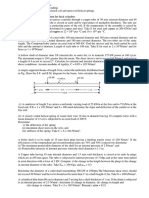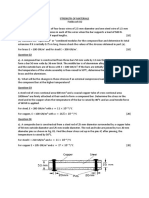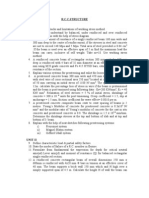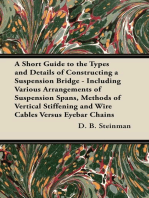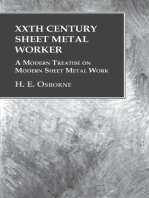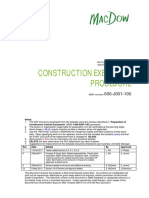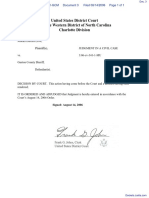0 ratings0% found this document useful (0 votes)
6 viewsCivil SM Unit 1
Civil SM Unit 1
Uploaded by
Sarathrajsm
Copyright:
© All Rights Reserved
Available Formats
Download as DOCX, PDF, TXT or read online from Scribd
Civil SM Unit 1
Civil SM Unit 1
Uploaded by
Sarathraj0 ratings0% found this document useful (0 votes)
6 views2 pagessm
Original Title
CIVIL SM UNIT 1
Copyright
© © All Rights Reserved
Available Formats
DOCX, PDF, TXT or read online from Scribd
Share this document
Did you find this document useful?
Is this content inappropriate?
sm
Copyright:
© All Rights Reserved
Available Formats
Download as DOCX, PDF, TXT or read online from Scribd
Download as docx, pdf, or txt
0 ratings0% found this document useful (0 votes)
6 views2 pagesCivil SM Unit 1
Civil SM Unit 1
Uploaded by
Sarathrajsm
Copyright:
© All Rights Reserved
Available Formats
Download as DOCX, PDF, TXT or read online from Scribd
Download as docx, pdf, or txt
You are on page 1of 2
SM UNIT I
1. A bar ABCD is made by rigidly connecting three bars of different materials and different
diameters and subjected to loading as shown in Fig.1. Find the stresses in each part of the
bar and total elongation of the bar. Take the values of E for steel, brass and aluminum as
200 GPa, 100 GPa and 70 GPa respectively.
2. A compound bar made of a steel rod 25 mm in diameter is enclosed in a brass tube of 26
mm internal diameter and 32 mm external diameter. The compound bar, 2400 mm long,
is fixed at the upper end and is rigidly fixed to a rigid plate at the lower end. Determine
the stresses in the bars when the combination is subjected to impact loading due to a
weight of 10 kN falling through a height of 5 mm. E for steel = 200 GPa and E for brass
is 100 GPa.
3. A solid brass cylinder 20 mm diameter is rigidly attached and surrounded by an
aluminium tube of internal diameter 20 mm and thickness 5 mm. If the assembly is stress
free at 28°C, find the stresses in the two materials when the temperature rises to 90°C.
For brass, E = 90 GPa and α = 20 x 10-6/°C, and for aluminium E = 70 GPa and α = 23 x
10-6/°C
4. A steel plate of constant thickness 14 mm is having a breadth of 120 mm at one end and
uniformly varies to a breadth of 80 mm at the other end. Find the total extension due to
an axial pull of 100kN at the ends. Take E = 206 kN/mm2 and length of the plate as 900
mm. Derive the formula involved from first principles
5. Write expressions for the relation between i) Modulus of Elasticity and Shear Modulus,
ii) Modulus of Elasticity and Bulk Modulus, and hence derive the relation among the
three elastic constants.
6. Find the minimum diameter of a steel wire with which a load of 50 kN can be raised so
that the stress may not exceed 125 MPa. Find the diameter chosen and also find the
extension of wire if it is 4.5 m long. Take E = 2.1× 105 N/mm2.
7. A copper rod 8 mm in diameter when subjected to a pull of 800N extends by 0.15 mm
over a gauge length of 450 mm. Find the modulus elasticity of copper.
8. A steel tube 45 mm internal diameter, 2.5 mm thick and 5 m long is covered throughout
with copper tube 5 mm thick. The tubes are firmly united at their ends. This compound
tube is subjected to tension and the stress produced in steel is 90 MPa. Determine i)
elongation of the tube ii) stress in the copper tube and iii) load carried by the combined
tube. Take Esteel = 210 kN/mm2 and Ecopper = 110 kN/mm2
9. A copper rod 8 mm in diameter when subjected to a pull of 960 N extends by 0.16 mm
over a gauge length of 450 mm. Find the modulus elasticity of copper.
10. A composite bar of length 900 mm is made up of an aluminum bar of length 450 mm and
the steel bar of length 400 mm. The cross-sectional areas of aluminum and steel bars are
120 mm × 120 mm and 80 mm × 80 mm respectively. Assuming that the bars are
prevented from buckling sideways, calculate the compressive force P to be applied to the
composite bar that will cause the total length of the bar to decrease by 0.4 mm. Assume
the modulus of elasticity of aluminum and steel as 72 kN/mm2 and 200 kN/mm2
respectively.
11. A load of 450 kN is supported by a square reinforced concrete (RC) column of size 300 ×
300 mm. The column is reinforced with 4 reinforcing bars of 20 mm diameter. If the
modulus of elasticity of steel is 16 times that of concrete, find (i) the stresses in steel and
concrete (ii) If the stress in concrete is limited to 5 MPa, what is the cross-sectional area
of steel required to carry an axial load of 500kN.
You might also like
- Questival Phoenix 2016Document7 pagesQuestival Phoenix 2016James GreenNo ratings yet
- MosDocument3 pagesMosrajapratyNo ratings yet
- The Following Observations Were Made During A Tensile Test On A Mild Steel Specimen 40 MM inDocument10 pagesThe Following Observations Were Made During A Tensile Test On A Mild Steel Specimen 40 MM inamdeva100% (2)
- Othm Level 6 Certificate IN Occupational Health AND Safety: Qualification Ref. No.: 603/5218/8Document46 pagesOthm Level 6 Certificate IN Occupational Health AND Safety: Qualification Ref. No.: 603/5218/8tabish_khattak67% (6)
- Family and Consumer ScienceDocument16 pagesFamily and Consumer ScienceCamille Battung100% (1)
- Rap Doc 1Document2 pagesRap Doc 1ravi2525No ratings yet
- DA - 1 - Strength of MaterialsDocument4 pagesDA - 1 - Strength of MaterialsRudransh KatiyarNo ratings yet
- QbankDocument8 pagesQbanknkchandruNo ratings yet
- Babu Banarasi Das: Practice QuestionsDocument7 pagesBabu Banarasi Das: Practice QuestionsNeeraj KshatriyaNo ratings yet
- Numericals From Unit 1 and 2Document16 pagesNumericals From Unit 1 and 2Ranganath RNo ratings yet
- Strength WorksheetDocument9 pagesStrength WorksheetHabtamu GetaNo ratings yet
- 18ME404 Assignment 1Document2 pages18ME404 Assignment 1BharanitharanNo ratings yet
- SOM Test QuestionDocument3 pagesSOM Test QuestionSathis KumarNo ratings yet
- Ce6306 16Document3 pagesCe6306 16Arul JONo ratings yet
- Som Prob SetDocument50 pagesSom Prob SetAnonymous mXicTi8hBNo ratings yet
- Unit 1 RamDocument3 pagesUnit 1 RamVENKATESHNo ratings yet
- MOM Assignment IDocument3 pagesMOM Assignment IAll_regNo ratings yet
- SOM-Practice Problems Part 1Document14 pagesSOM-Practice Problems Part 1indiaid1234247No ratings yet
- ExpectedDocument1 pageExpectedagdgaming100.mNo ratings yet
- SOM - Fieldwork 02Document1 pageSOM - Fieldwork 02Alexander MugabeNo ratings yet
- Assignment Strength of MaterialsDocument11 pagesAssignment Strength of MaterialsVinay Korukonda0% (1)
- Som Unit 1 and 2 Question BankDocument7 pagesSom Unit 1 and 2 Question Bankrkrajesh86No ratings yet
- Sterngth of MaterialsDocument2 pagesSterngth of Materialschandru civilNo ratings yet
- SOM Question Bank For RevisionDocument11 pagesSOM Question Bank For RevisiongoldencometNo ratings yet
- Strength 1 Practice Problems - 240119 - 231420Document7 pagesStrength 1 Practice Problems - 240119 - 231420john patrick punsalanNo ratings yet
- Problems in I UnitDocument6 pagesProblems in I UnitjeroldscdNo ratings yet
- SM Assignment 1Document1 pageSM Assignment 1vikram eedaNo ratings yet
- PropertiesDocument6 pagesPropertiesmarkalvinbonNo ratings yet
- 6 Statically Indeterminate MembersDocument13 pages6 Statically Indeterminate MembersShayneBumatayNo ratings yet
- Group Assignment NG, PE, MR, GL, PG & RPDocument2 pagesGroup Assignment NG, PE, MR, GL, PG & RPMensah BernardNo ratings yet
- MoS Tutorial QuestionsDocument13 pagesMoS Tutorial QuestionsMarxim Rahula BharathiNo ratings yet
- CE6306 QBDocument21 pagesCE6306 QBSivaNo ratings yet
- CE6306 SOM Important QuestionsDocument4 pagesCE6306 SOM Important QuestionsUTHIRANo ratings yet
- ProblemSet2 PDFDocument3 pagesProblemSet2 PDFAloysi DelouizaNo ratings yet
- Ce003 PsDocument4 pagesCe003 PsJaimeNo ratings yet
- Mechanics of Solids Ii Year/ Iv Semester Unit I Stress and Strain Part - ADocument14 pagesMechanics of Solids Ii Year/ Iv Semester Unit I Stress and Strain Part - AMohsin MullaNo ratings yet
- Compound BarssssDocument8 pagesCompound Barssssface the fearNo ratings yet
- Ce 6306 Som QBDocument11 pagesCe 6306 Som QBHODMECHANICAL AKTMCETNo ratings yet
- Assignment 3Document3 pagesAssignment 3parmodrtkNo ratings yet
- RCC QB - 030410041238 - 1Document4 pagesRCC QB - 030410041238 - 1dsureshcivilNo ratings yet
- Mom AssignmentDocument8 pagesMom AssignmentfrogNo ratings yet
- Machine Design QuestionDocument2 pagesMachine Design Questionihossain1424No ratings yet
- B.Tech Assgn-1Document6 pagesB.Tech Assgn-1K Pushpendu PrashantNo ratings yet
- Tutorial 2 Chapter 3 - Mechanical, Electrical and Thermal PropertiesDocument2 pagesTutorial 2 Chapter 3 - Mechanical, Electrical and Thermal PropertiesHafizatul AqmarNo ratings yet
- Strength of MaterialsDocument6 pagesStrength of MaterialsRafael Santos100% (1)
- SOM Assignment No 2Document4 pagesSOM Assignment No 2suhani mittalNo ratings yet
- Aat 1Document4 pagesAat 1HARNITH EVILLNo ratings yet
- Som Model 3Document3 pagesSom Model 3krish2005yahooNo ratings yet
- Worked Solution To Various QuestionsDocument29 pagesWorked Solution To Various QuestionsJohn MutumaNo ratings yet
- Practice-Problems Machine Design 1Document2 pagesPractice-Problems Machine Design 1Joyce dela CruzNo ratings yet
- 7 - MOS-I Assignment QuestionsDocument5 pages7 - MOS-I Assignment QuestionsSrikant Potluri100% (1)
- Assignment No 1 MD-1..Document3 pagesAssignment No 1 MD-1..Yadnyesh TaNo ratings yet
- MOM2Tutorial 10-1Document3 pagesMOM2Tutorial 10-1Ishola mujeebNo ratings yet
- Som II QuestionsDocument3 pagesSom II Questionsfaltuvideo msNo ratings yet
- Assignment 1Document4 pagesAssignment 1TanmayNo ratings yet
- Solid Mechanics Question BankDocument10 pagesSolid Mechanics Question BankMugilan VinsNo ratings yet
- Question Bank MOSDocument7 pagesQuestion Bank MOSsanketNo ratings yet
- A Short Guide to the Types and Details of Constructing a Suspension Bridge - Including Various Arrangements of Suspension Spans, Methods of Vertical Stiffening and Wire Cables Versus Eyebar ChainsFrom EverandA Short Guide to the Types and Details of Constructing a Suspension Bridge - Including Various Arrangements of Suspension Spans, Methods of Vertical Stiffening and Wire Cables Versus Eyebar ChainsNo ratings yet
- The Study of Elementary Electricity and Magnetism by Experiment: Containing Two Hundred Experiments Performed with Simple, Home-made ApparatusFrom EverandThe Study of Elementary Electricity and Magnetism by Experiment: Containing Two Hundred Experiments Performed with Simple, Home-made ApparatusNo ratings yet
- The Study of Elementary Electricity and Magnetism by Experiment: Containing Two Hundred ExperimentsFrom EverandThe Study of Elementary Electricity and Magnetism by Experiment: Containing Two Hundred ExperimentsNo ratings yet
- A Guide to Some of the Equations used in Constructing a Suspension BridgeFrom EverandA Guide to Some of the Equations used in Constructing a Suspension BridgeNo ratings yet
- XXth Century Sheet Metal Worker - A Modern Treatise on Modern Sheet Metal WorkFrom EverandXXth Century Sheet Metal Worker - A Modern Treatise on Modern Sheet Metal WorkNo ratings yet
- Temas Persuasivos de Ensayo Sobre AnimalesDocument8 pagesTemas Persuasivos de Ensayo Sobre Animaleslzmoywmpd100% (1)
- Attendence Management SystemDocument78 pagesAttendence Management SystemSupernatural अद्भुत100% (2)
- Construction Execution ProcedureDocument13 pagesConstruction Execution ProcedurejackNo ratings yet
- G.R. No. 99289-90 (Santiago Vs Vasquez)Document8 pagesG.R. No. 99289-90 (Santiago Vs Vasquez)Hannika SantosNo ratings yet
- Essay 5 Practice Activities - DBS IntroductionsDocument6 pagesEssay 5 Practice Activities - DBS IntroductionsLeyla IsayevaNo ratings yet
- Lombok 3 Sales HandoutDocument1 pageLombok 3 Sales HandoutAnonymous gMgeQl1SndNo ratings yet
- Model Predictive Automatic Control of Sucker Rod Pump System WithDocument63 pagesModel Predictive Automatic Control of Sucker Rod Pump System WithAlexander Aristizábal PeñalozaNo ratings yet
- Error Free Liquid Flow Diverters For Calibration FDocument9 pagesError Free Liquid Flow Diverters For Calibration FMarco LatosaNo ratings yet
- F6 Economics 2019 - CompressedDocument39 pagesF6 Economics 2019 - CompressedLent TafoleheNo ratings yet
- August Losch Model of Central Place: Prof. Nizamuddin Khan D/O Geography, AMU, AligarhDocument17 pagesAugust Losch Model of Central Place: Prof. Nizamuddin Khan D/O Geography, AMU, AligarhVishvarajNo ratings yet
- This Essay Will Discuss About These Causes and Solutions of Air PollutionDocument4 pagesThis Essay Will Discuss About These Causes and Solutions of Air PollutionLam ThuyênNo ratings yet
- Assignment - Principles of Acct. - Ii PDFDocument3 pagesAssignment - Principles of Acct. - Ii PDFbereket nigussieNo ratings yet
- Supercritical Turbine TrainingDocument7 pagesSupercritical Turbine TrainingEngr Imtiaz Hussain GilaniNo ratings yet
- Business Law Lecture Notes (UEBS)Document112 pagesBusiness Law Lecture Notes (UEBS)eholmes8095% (20)
- Know All Men by These Presents:: Deed of Sale of Motor VehicleDocument3 pagesKnow All Men by These Presents:: Deed of Sale of Motor VehicleJialing FuNo ratings yet
- The Legalized Crime of BankingDocument143 pagesThe Legalized Crime of Bankingmuslimvillages100% (1)
- IC IT Project Status Report Powerpoint 11839 PowerpointDocument12 pagesIC IT Project Status Report Powerpoint 11839 PowerpointSamrong Chek BENo ratings yet
- Love v. Gaston County Sheriff Dept. - Document No. 3Document1 pageLove v. Gaston County Sheriff Dept. - Document No. 3Justia.comNo ratings yet
- Assignment 1 Research Proposal 5%Document2 pagesAssignment 1 Research Proposal 5%umarNo ratings yet
- PGH Session Tunebook PrintDocument204 pagesPGH Session Tunebook PrintXavier BettecherNo ratings yet
- Bar Ans Er EEDocument10 pagesBar Ans Er EEODYLOU CAMILLE MONTOJONo ratings yet
- CSM Workshop Handout - Vijay Bandaru - Version 7.17 (Aug 2023)Document129 pagesCSM Workshop Handout - Vijay Bandaru - Version 7.17 (Aug 2023)KarthikeyanVeeNo ratings yet
- Stepper MotorDocument59 pagesStepper Motorya zool / يا زولNo ratings yet
- 05 - APRILIA P - F3318016 - Tugas TensesDocument4 pages05 - APRILIA P - F3318016 - Tugas TensesSolekNo ratings yet
- Cylindrical Roller Bearings For The Backing Shafts of Cluster MillsDocument10 pagesCylindrical Roller Bearings For The Backing Shafts of Cluster Millsrochim_putech_126885No ratings yet
- Atrasorb Pharma FreeDocument2 pagesAtrasorb Pharma Freeneelshah952001No ratings yet
- Basf Masterflow 678 TdsDocument4 pagesBasf Masterflow 678 Tdsgazwang478No ratings yet


















